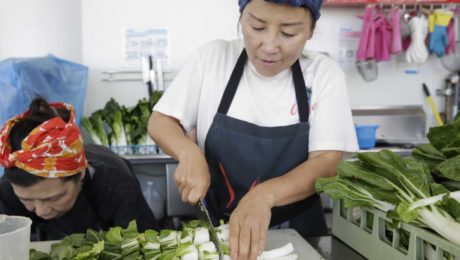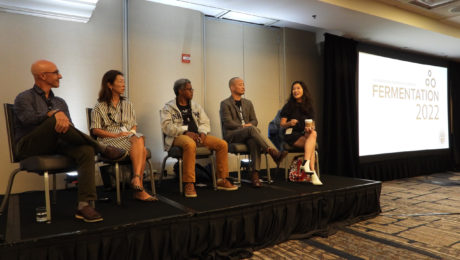Educating Consumers About Fermentation
Fermentation continues to top food trend lists, health movements and restaurant menus, influencing more curious consumers to buy fermented foods. But the average consumer remains fermentation clueless.
“Fermentation is a really complicated subject and we’re just reaching the tip of the iceberg at this point when it comes to the research,” says Jenna Mills, account manager at Eat Well Global, a food and nutrition consulting agency. “A complicated subject like this is loaded and I feel that individuals and consumer know just enough to be confused.”
Five food professionals shared their thoughts on how to educate consumers about fermentation during a panel at FERMENTATION 2022. Panelists included: Mills, Shannon Coleman (associate professor and state extension specialist at Iowa State University), Matt Lancor (CEO and founder of Kombuchade), and Kirsten Shockey (author, educator and co-founder of The Fermentation School and TFA Advisory Board member). Amelia Nielson-Stowell, editor at The Fermentation Association, moderated.
Simple Messaging
The panelists agreed fermentation brands need to stop overcomplicating fermentation to the consumer, focusing on simple communication strategies.
“I compare it to a small child asking where babies come from – a simple answer is enough,” says Shockey. “With fermentation, often, we’re ready to say that lactic acid bacteria come in and they’re eating carbohydrates and there are these metabolites and flavors involved. We’re ready to share all the details – and we’re met with a blank stare. People just often want to know what’s the difference between a pickle and a ferment.”
Shockey, who teaches at the women-run Fermentation School, says she’s felt pressure over the years to innovate her classes and teach new subjects. But, especially since the Covid-19 pandemic when more consumers focused on health and turned to fermentation, her most popular classes are still the basic fermentation 101.
In a TFA survey last year, 70% of fermentation producers said a greater understanding of fermentation and familiarity with the flavors associated with fermentation would foster increased consumption of fermented foods.
Kombuchade is taking a unique approach to that education component, focusing on kombucha as a recovery drink.
“I’m looking to make probiotics cool for athletes, much like Gatorade made electrolytes cool for athletes,” Lancor says. The science of food is typically a mechanical process: eat fats, carbohydrates and proteins for optimal energy and performance. “There’s actually a microbial fermentation process that’s helping to rebuild your muscles.”
Kombucha marketing is geared toward a yoga, enlightenment crowd, Lancor adds, only reaching a certain number of consumers. It doesn’t resonate with all consumers.
“The south side of Chicago guys that play on my rugby team, they were never going to grab that kombucha bottle off the shelf with that kind of messaging,” he says. “There wasn’t this message of probiotics can be used for performance or recovery or even understanding kombucha’s place within an athlete’s regimen.”
Communicating Science & Tradition
Fermented food brands are tasked with bridging the gap between science and consumer.
Consumers keep informed about food and nutrition trends through professional associations (69%), academic (67%) and dietitians and nutritionists (62%), according to a consumer insights survey by Eat Well Global.
For 77% of consumers, the advice of dietitians and nutritionists impacts which foods they buy. Mills says healthcare professionals offer that counseling on how to incorporate fermented foods into the diet.
Don’t forget the ancestral wisdom, Shockey points out.
“My one liner is we’ve evolved with these foods and you are here because your ancestors successfully fermented,” she says. Rather than educating that people should eat a tablespoon of sauerkraut a day to meet nutrition needs, “try to bring it into your world naturally.” Eat a mixture of ferments, with yogurt at breakfast or hot sauce at lunch and kimchi at dinner.
“We cannot put ferments into this box that must be eaten raw. That to me is a barrier. You should eat this in any way that feels right to you,” she says, adding ferments were traditionally eaten cooked in soups and stews. “But in our minds right now is the idea that we have to eat our probiotics raw. These foods have so many metabolites that are being created in production and they follow through in the cooking process.”
Challenges to Starting a Brand
Starting a fermentation brand can be an overwhelming task. Sandor Katz, fermentation author and educator, said in his keynote address at the FERMENTATION 2022 conference that education is a huge challenge for people launching new fermented products.
“They often end up putting a lot of their energy into educating consumers,” he says.
Coleman says state extension offices are an underutilized resource for new producers. Her office got into food preservation after noticing many Pinterest recipes that gave poor advice on food safety.
“Just about every extension program has some form of food preservation type of program that they are delivering to consumers and they want to help,” Coleman adds.
There are no universal standards for labeling, an obstacle for new producers.
“Labeling is such a sensitive issue because you can get into big trouble with the FDA,” Nielson-Stowell says, pointing out the U.S. Food & Drug Administration only has 12 approved health claims a brand can put on a label. “It also gets tricky putting ‘probiotic,’ ‘prebiotic’ or ‘postbiotic’ on a label. It’s not regulated and confusing to consumers.”
The International Scientific Association of Probiotics & Prebiotics (ISAPP) is pushing for -biotics to be a more protected term. According to ISAPP, only fermented food brands with a scientifically measured -biotic should but it in a label. Their health benefits must be documented. For example, yogurts often have defined probiotic strains on their labels.
Nielsen-Stowell recommends using “live cultures,” “live microbes” or “naturally fermented” instead. And make sure retailers know what that means.
“If you’re getting your set in store with a retailer, the retailer will be your biggest advocate. The retailer is going to be the one talking to the customers more than you. Educate them. Do they know why your product is better than your competitor’s product?” she adds.
SF’s Vegan Kimchi Queen
Aruna Lee’s path to running a fermented food brand is riveting, from her journey as an orphan to Buddhist nun to founder of Volcano Kimchi.
Lee’s story is detailed in a San Francisco Chronicle feature. Adopted by her teacher, she remembers sneaking out of bed in the middle of the night and digging up dongchimi, a winter radish kimchi fermented in large crocks buried in the ground. Later, as a nun in seminary school, Kimchi was communally made during gimjang, the process of kimchi making. The members of the monastery would prepare bulk batches in winter and spring in a large bathtub, storing it in underground crocks.
Curious about the world, Lee later left the monastery and traveled the world. She met her husband and eventually made roots in San Francisco. After the recession forced her to leave her career in the nonprofit sector, she began making kimchi for sale at farmers markets in 2014 without any professional cooking experience. Her organic kimchi is made similarly to how she learned in the monastery — including keeping it vegan.
“When you add fish sauce and shrimp paste, it overpowers everything and you don’t taste each ingredient. When you add simple ingredients, it’s balanced. It has a harmony of that flavor,” Lee says.
Read more (San Francisco Chronicle)
- Published in Business, Food & Flavor
Promoting Fermentation Innovation
Several obstacles prevent the innovation of fermented foods, from the lack of scientific research to a chasm between science and industry to improving the sustainability of traditional ferments.
A third of foods consumed worldwide are fermented, totalling 3,500 products. A group of European scientists is studying how those fermented foods can drive innovation in food systems.
“There’s not a clear way to improve the unique properties of traditional fermented foods using microbial organisms,” says Vittorio Capozzi, PhD, a researcher with the Institute of Sciences and Food Production (ISPA) in Italy. “We still need innovation in traditional fermented foods.”
Capozzi was one of the presenters at a side event during the October Food & Agriculture Organization of the United Nations Science and Innovation forum. PIMENTO hosted the session. PIMENTO (which stands for “Promoting Innovation of ferMENted fOods”) launched last year in Europe, a project of the European Cooperation in Science and Technology (COST). PIMENTO aims “to place Europe at the spearhead of innovation on microbial foods” by promoting fermentation’s health, diversity and production. To achieve this goal, five working groups are structured around different fermentation topics. The groups are made up of both scientist and non-scientist fermentation experts studying and eventually implementing their findings.
Traditional ferments have “an important part of biodiversity that we cannot neglect,” Capozzi says. Fermentation provides new microbial-based solutions for a variety of foods, from plant-based ferments to alternative proteins. Innovations can improve nutrition and sensory qualities.
“In this way we are preserving biodiversity that has huge potential in biotechnology, science and innovation,” he says.
Ferments, he notes, can be protected. For example, a ferment produced in a specific geographical region (tequila in Mexico), a protected diversity, vegetable type, animal product or the human behavior used in production (Salers cheese in France).
“Fermented foods have been shaped through the centuries,” says Effie Tsakalidou, professor at the Agricultural University of Athens in Greece. “We have a lot of diversity.”
One of PIMENTO’s tasks is to create a database on European fermented foods. This list would include food types, production, consumption volume, technological parameters and legal status (like certifications).
Speaking on the health benefits and risks of fermented foods, Smilja Todorović, PhD, a professor at the Institute for Biological Research in Serbia, notes there’s a dearth of reputable, peer-reviewed studies on fermented foods.
“One of the very important things is to identify gaps in scientific evidence regarding benefits and risks,” she says.
The current studies on fermented foods are few and limited. Research does prove consuming fermented foods is correlated with overall mortality, decreased risk of diabetes, certain cancer types, high blood pressure and cardiovascular diseases. Todorović says that’s not enough.
“Unfortunately, when we look at scientific evidence to claim health properties, we can see that there are insufficient evidence. So all we have is a growing scientific interest in fermented foods and their impact on human health. However, we need to move from promising results to scientific evidence,” he says.
PIMENTO’s working groups are cataloging fermented foods’ impact on the gastrointestinal symptom, allergies, immunity, bone health and neurological projects. They also plan for projects studying fermented foods bioactive compounds, vitamin production and functionality; and fermented foods use in personalized diets.
The lack of studies prevents innovations in the field. Antonio del Casale, co-founder and CEO of Microbion, an agro-industrial microbiology company, says there is a disconnect between the scientists studying fermented foods and fermented food producers. He calls it “a valley of death.” The research on fermented foods is low, but the development of commercial resources are increasing.
“The problem is how to avoid the limitations of developing the food in this sector,” he says.
Traditions of Fermentation, Cultural Appropriation & Diversity
Cooking isn’t limited to only making the dishes of one’s ethnicity. The cultural identity of that food becomes murky when it gets transactional. Commercializing a food without respecting and honoring its history and tradition is inauthentic, damning to immigrant producers and threatens to erase traditional foods.
“Someone with more power or dominance, they can create their own kimchi – that doesn’t have any resonance to its tradition – and get it on the shelves of Wal-Mart and make it commercially successful. I don’t have that opportunity because I’m a woman, I’m Korean, I’m a minority and I’m just trying to tell the story about kimchi in my way,” says Lauryn Chun, founder and CEO of Mother-in-Laws kimchi. Chun’s kimchi comes from her mother’s recipe used in the family restaurant in California, Jang Mo Jip. “It’s my heritage of food that I enjoy sharing with Americans.”
Chun’s experience is similar to many BIPOC producers. It’s difficult for minority producers to compete with the white-owned brands that often have more money to launch a food company and receive preferential treatment by retailers for store placement.
“When you turn it into a business and you’re profiting as a company, we need to be more sensitive and more deliberate in how we give credit to people,” adds Robert Danhi, chef and co-founder of Flavor360 Solutions (and a TFA Advisory Board member)
Speakers discussed the wide range of issues related to traditional foods in a panel during TFA’s conference FERMENTATION 2022 titled “Traditions of Fermentation, Cultural Appropriation and Diversity.” Panelists included Chun, Danhi, Beverly Kim (chef and owner of restaurants Parachute and Wherewithall in Chicago), Kheedim Oh (founder of Mama O’s Premium Kimchi and TFA Advisory Board member) and Ismail Samad (founder of Loiter and Wake Robin Foods). The discussion was moderated by Josephine Wee (assistant professor at Penn State University and a TFA Advisory Board member).
Do Cultures Own Their Foods?
“There’s appropriate appropriation,” says Oh, whose Brooklyn-based kimchi brand is also based off the recipe of Oh’s mother, a Korean American. “Some of these brands, is what they’re making even kimchi? Kimchi is such a popular buzzword now. But it’s an unfair advantage when you’re competing with me and Lauryn to get your kimchi on the shelf and it’s very loosely kimchi.”
Brands are coming to retail with condiments labeled kimchi that are far from the traditional Korean condiments. They’re skimping on ingredients, like not using traditional Napa cabbage and opting for cheaper produce varieties. Though there’s hundreds of versions of traditional kimchi, some brands are veering too far to gain sales (Oh joked about a raspberry cheesecake kimchi).
“We need to change the narrative from appropriate to appreciation, celebration and preservation,” Wee adds.
Should a culture own a fermented food? Like Koreans just selling kimchi? The panel didn’t agree with that notion. But Samad points out a culture’s food is taken away from them when it’s exploited.
Through his nonprofit Loiter, Samad tackles the effects of systemic racial and economic injustice. He’s helping the residents of East Cleveland by developing successful, community-owned businesses – like Wake Robin Foods, a fermented food brand Samad purchased. Wake Robin will create ferments using produce from local, urban farmers.
“It’s black owned by black farmers so we can get some black dollars circulating in our culinary economy so they can have some freaking version of reparations for what has happened,” Samad says. “For me this is straight financial, who gets the opportunity to scale up.”
Samad says there’s an entire food system of African fermented foods “not being appropriated or appreciated in the U.S.” He hopes to disrupt the market.
“There’s an opportunity to introduce products that are owned by own by us, and by us I mean the African Diaspora,” he says.
Nuances in International Dining
Many American diners, though, are “still even at the elementary level of understanding the differences between different cultures in a diaspora,” says Kim, a former Top Contestant. “Asian cuisine is not just one monolithic cuisine.”
Some pan-Asian restaurants sell sushi (Japan) alongside kimchi (Korea) and pad thai (Vietnam), a “mish mash” of foods from different Asian countries. “We have to “continuously dig deeper to show there are nuances between the cultures,” she says.
It can be a difficult concept for chefs, too, who are trained in primarily French cuisine at culinary school. When Kim went through culinary school, a short quarter was focused on global foods, “the rest is basically Fresh cuisine.”
Ethnic food — especially Asian fare— the food is often stereotyped as cheap, “it’s a bamboo ceiling that you can’t charge high prices,” Kim says. Western diners often don’t take into account the differences in quality of ingredients or the creativity, care and time in cooking a dish. “We’ve been seen as cheaper because we’re Asian, so people question why our prices are so high.”
Chun, who grew up helping in the family’s Korean restaurant, began Mother-in-Law’s kimchi questioning why kimchi wasn’t in the ranks of specialty craft foods like fine cheese.
“From the perspective of western fermented foods, from cheeses to wines to craft beers, those are the only things people are willing to spend their money on,” Chun says. She adds she felt very proud to be the first kimchi in specialty grocery store chain Dean and Deluca.
In retail, many international food brands get placed in the ethnic aisle. But why does a sauce from an international region get placed in the ethnic aisle while spaghetti is placed in the sauces aisle?
“I’m torn over the concept of that existing,” Oh says. “We’ve been subjugated to the ethnic aisle aka the global ghetto where there’s no reason for it except the fact that I’m Korean.”
Cultural Regulatory Bias
Are there conflicts between tradition and science? Panelists shared how some health regulators don’t understand cultural ferments, causing batches of fermented food to be deemed unsafe for human consumption and thrown out.
Kim attempted to start a wholesale kimchi brand during the brand. Studies prove kimchi is made safely at a pH range of 4.2-4.5, but the regulator from the health department was told Kim legally had to keep kimchi under pH levels 3.3 to keep it safe.
“There’s so much confusion around it, I had to reach out to food scientists to clarify it, and we don’t want to get in trouble,” Kim says. She ended up cancelling the brand because securing regulatory approval was so difficult.
Oh adds: “I think there’s a big cultural bias when it comes to fermented foods. In the U.S., it’s either the food is 100% clean scrubbed and pasteurized or it’s not – and the not is dangerous and dirty. Where fermented foods predates modern electricity and modern science, there’s a reason why it’s safe because it works out that it’s a very safe food because, through the lactic acid fermentation, it lowers the pH and that helps preserve the food.”
- Published in Business, Food & Flavor
Is the Future of Sake Canned?
Despite dedicated U.S. sake programs and educated American sommeliers, sake has been a harder sell in U.S. Federal regulations have never been able to properly define the drink. It’s taxed as a beer, but regulated as a wine. Education is a big issue. Many Americans think sake is a wine, causing them to drink too much of it and feel sick. Sake is brewed from fermented rice, making it similar to a beer.
“There’s a learning curve, but there’s also a bit of a cultural barrier. Sake can come across the way wine can — this very sophisticated product that’s expensive and that’s a bit esoteric, like you can’t really appreciate it unless you know all the nomenclature,” says Weston Konishi, president of the Sake Brewers Association of North America. “And then there’s the fact that Japanese sake tends to be labeled in Japanese, which most Americans can’t read. That’s been something of a barrier.”
Now more sake brewers are putting their sake in cans, making easy-to-purchase, grab-and-go options. It’s cheaper, too, at $5 a can versus $30 for a bottle.
“There’s something less intimidating about a can versus a bottle — that’s one advantage to canning sake. It’s not so erudite and out of reach,” says Konishi.
Inside Hook highlights six brands selling sake in cans.
Read more (Inside Hook)
- Published in Business
Food Regulations Fall Short on Diversity
The laws around food production are confusing, costly and “don’t reflect diversity in food.” Cottage food producer laws allow budding chefs to start making ferments for retail sales, “but only if they’re made a certain way.”
An article in Minnesota Public Radio highlights a major gap in food regulation: immigrants are left out. Though food laws cover fermented kimchi and kombucha, for example, they’re restrictive for less common fermented foods and beverages from different cultures. Vino Raj, owner Square Root of Curry in Minnesota, points out that if he tried to make a fermented product from his native country, he’d have to “fundamentally change” the product to follow the state’s rules, “rendering them inauthentic.”
“You don’t see lots of South Indian foods because of that law,” he said. “The laws have not caught up to other forms of cooking.”
The barriers for immigrants wanting to start a small food business are especially high. Procedures often aren’t translated into other languages, commercial kitchens are challenging to find and expensive to rent, insurance and licensing is costly.
Pictured, Dao See, owner of Minne Street Rolls, sells traditional Lahu food and is advocating for Minnesota to sell more diverse food.
Read more (Minnesota Public Radio)
- Published in Business
Consumers: We’d Eat More Fermented Foods if Knew Health Benefits
The general public lacks knowledge of fermentation and does not understand the health benefits. Nearly 85% of respondents in a survey said they would consume more fermented foods if they knew more about fermentation’s health benefits.
The study illustrates much work is needed in educating consumers. Over 83% of respondents didn’t know the definition of fermentation and over 60% had limited knowledge of the microorganisms involved in fermentation. Most learned about fermented foods at school (31%), the internet (29%) or home (26%). And 72% said they felt safe consuming fermented foods.
Researchers from the University of Maribor in Slovenia studied how much people in the country know about fermentation. The results were eye-opening, especially since fermentation is more common in Europe. The study notes Slovenians commonly grow up eating local fermented foods, like sauerkraut, sour turnip and sour milk, especially in rural areas.
“Despite the fact that less than one fifth of the participants were familiar with the definition of fermentation and understood the process, almost one-third of the participants at least tried to ferment at home,” the study concludes. “Fermented foods should once again become part of the diet to improve overall health and reduce or postpone the onset of a variety of chronic diseases that plague us today.”
Read more (BMC Public Health)
Inuit Scientist on Ferments of the Arctic
When Aviaja Lyberth Hauptmann, PhD, began her research into the metagenomics of snow and ice environments, she was surprised that plant-based diets were a constant focus in the field of human gut microbiome research.
“I wondered why no one seemed to acknowledge that some peoples, and in particular Arctic Indigenous peoples, have lived healthily off animal-source foods for millennia,” she says. “It was clear to me that there is a large gap in our understanding of how healthy animal-source foods affect the microbiome. And not just animal-source foods, but foods that are not industrially produced, foods that come straight out of our environment, including microbes from our environment.”
This has become central to Hauptmann’s research. She’s published two papers on Inuit foods. Her latest, on Inuit ferments, was published with Maria Marco, PhD, food science professor at University of California, Davis (TFA Advisory Board member). That study, published in the journal Microbiome Research Reports, concluded the way to “understand the value of these traditional animal-sourced foods” is to combine new microbiological techniques with projects led by the Inuit “who make and consume fermented foods.”
In an interview with Microbiome Research Reports, Hauptmann notes that most people consider the Arctic a harsh, barren and cold place. “But Inuit describe the vast sea ice as some might describe a garden. It is full of life and food. The Arctic is a source of diverse and abundant diets if one knows how to tap into the abundance and diversity, and an important aspect of that is food preservation and of course fermentation.” Inuit store meat and other food when it’s been abundant, so fermentation has played a central role for the last 300 years. She hopes Inuit people will still take part in that local culture, eating and preserving the local foods.
Read more (Microbiome Research Reports)
- Published in Food & Flavor, Science
Chefs Turn to Fish Sauce for Flavor Punch
Fish sauce has been used for centuries as a umami “flavor bomb” for dishes. An article in British Post Magazine highlights how chefs throughout the world use regional variations of fish sauce – from Vietnamese nuoc mam, Malaysian belacan, Filipino bagoong and Italian colatura.
“Fermentation has been an integral part of many traditional food cultures to develop flavourful foodstuffs,” says Ana San Gabriel, who specializes in umami taste receptors and physiology at food and biotech company Ajinomoto.
San Gabriel details that fish sauce is made from the proteins (myosin, troponin and titin) from the flesh of fish that are broken into umami compounds (peptides and free glutamate) through salting and fermentation.
Belacan is a staple of Malaysia’s coastal cuisine. It’s a shrimp paste used in curries and sambals.
“Belacan has a deep history and heritage in Malaysia, and for many locals it evokes fond memories of family gathered together to make it from scratch,” says Jasper Chow, the executive sous chef at One&Only Desaru Coast, a luxury beachfront resort in Malaysia. “Making belacan is a delicate process that reminds us of the simple yet sophisticated methods of cooking that survive even until today.”
In Vietnam, nuoc mam is made in the southern island of Phu Quoc. It can be made from fish, shrimp or crab.
“As a dip, it highlights the sweetness and clears the greasiness of meat and deep-fried bites. It gives an exciting flavor to, yet never buries, the beautiful natural taste of fresh rolls,” says Pham Van Nhuong, the sous chef in the kitchen at Vietnam’s Tempus Fugit. “As a seasoning, unlike salt, it adds to braises, stews and even stir-fries a vigorous flavor and a signature scent.”
Bagoong in the Philippines is made from fish or krill.
“Bagoong is one of the building blocks of umami, or linamnam, in Philippine cuisine. Sometimes it’s used as a condiment or flavor for an existing dish, sometimes it will be the actual component or basic building block of a dish – like the dish binagoongan, which literally means ‘you used bagoong’,” says chef Jordy Navarra, chef at Toyo in Manila.
Colatura di alici is Italy’s modern version of garum, made from salted and fermented anchovies along Italy’s Amalfi Coast.
“We use colatura as a subtle addition to many dishes and in doing so have nearly completely removed the use of sea salt for sauces and purées,” says Antimo Maria Merone (pictured), chef at Neapolitan restaurant Estro in Hong Kong. “This allows us to precisely reach the level of sapidity by adding a certain percentage of fish sauce to the preparations that lack natural umami.”
Read more (Post Magazine)
- Published in Food & Flavor
Mexican Hard Cider
An Oregon cidery is taking an interesting approach to hard cider, ciders inspired by aguas frescas.
La Familia Cider Company founder José Gonzales is a first-generation Mexican-American. He runs La Familia Cider Company with his wife, Shani, and their kids Jay Jay and Jezzelle. José and Shani grew up drinking aguas frescas, but couldn’t find those drinks in Oregon.
“As my wife and I were enjoying Oregon craft beer and cider, she said, ‘Too bad there aren’t any of the flavors we grew up with,” José said. So they developed their own brand with flavors reflecting their heritage.
Their ciders are from freshly-picked, northwest-grown apples, but the flavors reflect the family’s Mexican heritage. Mainstay flavors include Manzana, Tamarindo and Hibiscus.
“With our ciders we wanted to do something a little bit different,” explained Jay Jay. “Change up the game a little bit.”
Today, the Salem, Ore.-based brand is in more than 50 stores in Oregon and Washington.
Read more (KGW8)
- Published in Business, Food & Flavor










